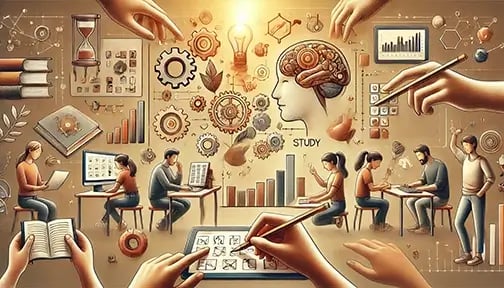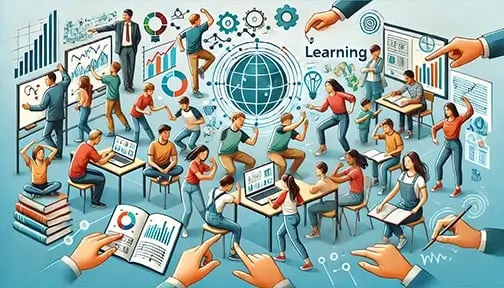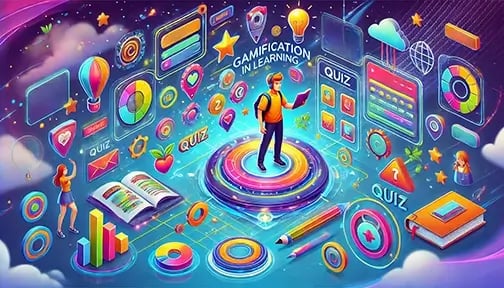Learning isn’t just about reading textbooks and listening to lectures. Engaging multiple senses, especially through hands-on learning, can significantly improve retention, understanding, and recall. Whether you’re a student, educator, or lifelong learner, incorporating tactile memory strategies can make studying more effective and enjoyable.
In this article, we’ll explore the benefits of this style of learning, discuss various tactile memory techniques, and provide practical tips to enhance retention. Plus, we’ll share links to Debra Dale Designs study card products—the perfect tools for interactive learning experiences!
Why Hands-On Learning Works
Hands-on learning, also known as kinesthetic learning, involves actively engaging with the material through movement, touch, and physical activities. Research shows that learning by doing helps strengthen neural pathways, making information easier to recall. It also supports different learning styles that benefit from touch and movement.
Key Benefits of Hands-On Learning:
Improves memory retention: When learners physically manipulate materials, their brains form stronger connections to the information for long term recall.
Enhances engagement: Tactile activities keep learners involved, reducing boredom and distractions.
Encourages deeper understanding: Instead of passively absorbing information, hands-on learning promotes critical thinking and problem-solving skills.
Supports different learning styles: While some people learn best by reading or listening, many benefit from the added reinforcement of touch and movement.
Tactile Memory Strategies for Different Age Groups
Hands-on learning benefits people of all ages. Below are specific memory strategies tailored to different learners.
1. Hands-On Learning for Young Children
Young children naturally explore the world through touch. Encouraging tactile learning from an early age can set a strong foundation for future academic success.
Best Tactile Memory Strategies for Kids:
Flashcard Sorting Games: Use Debra Dale Designs study cards to create fun matching activities.
Letter and Number Tracing: Writing letters in sand, shaving cream, or with finger paints reinforces recognition.
Manipulative-Based Math: Using counters, blocks, or beads helps children understand basic math concepts.
Storytelling with Props: Acting out stories using small objects or puppets enhances comprehension and recall.
2. Tactile Learning for Students and Teens
As students advance, hands-on learning remains crucial for reinforcing complex subjects.
Memory Strategies for Middle & High School Students:
Index Card Drills: Writing key terms, formulas, or historical dates on ruled study cards makes memorization easier.
Mind Mapping with Sticky Notes or Cards: Rearranging concepts physically helps organize thoughts for essays and projects.
Science Experiments & Lab Activities: Engaging with materials firsthand solidifies understanding of scientific principles.
DIY Study Games: Create memory-matching or trivia-style games to test knowledge interactively.
3. Hands-On Learning for College Students and Adults
Tactile learning doesn’t stop after high school. College students and professionals can still benefit from interactive techniques to master new skills.
Effective Tactile Memory Strategies for Adults:
Flashcard Repetition with Movement: Walk around while reviewing Debra Dale Designs study cards to engage both mind and body.
Note-Taking by Hand: Studies show that physically writing notes improves retention more than typing.
Building Models or Diagrams: Whether it’s anatomy, engineering, or business concepts, physically constructing models enhances comprehension.
Hands-On Problem Solving: Actively working through real-world case studies or simulations strengthens memory and application skills.
How to Incorporate this into Your Study Routine
No matter your age, integrating tactile memory strategies into your routine can improve your ability to recall information. Here’s how:
1. Use Study Cards for Active Recall
Flashcards are one of the most effective tools for this style of learning. By repeatedly testing yourself, you reinforce connections in your brain. Debra Dale Designs study cards are ideal for:
Vocabulary building
Math equations
Historical facts
Language learning
2. Engage in Multisensory Learning
Combining tactile learning with auditory and visual elements enhances memory retention.
Read information aloud while using index cards.
Use color-coded notes to visually organize concepts.
Incorporate music or rhythms to remember key details.
3. Create Hands-On Study Stations
Setting up a dedicated learning space with physical study aids keeps you engaged.
Keep flashcards, highlighters, and models easily accessible.
Use a whiteboard to visually map out ideas.
Incorporate interactive tools like puzzles or sorting activities.
4. Teach What You Learn
Explaining a concept to someone else solidifies your understanding. Try:
Teaching a friend using flashcards or diagrams.
Role-playing historical or scientific scenarios.
Recording yourself explaining topics and listening back.
Debunking Common Myths About Hands-On Studying
Despite its proven benefits, some misconceptions persist about the hands-on learning method.
❌ Myth 1: Hands-on learning is only for kids.✅ Reality: Kinesthetic learning benefits all ages, including older professionals mastering new skills.
❌ Myth 2: It takes too much time.✅ Reality: Hands-on activities often improve efficiency by enhancing comprehension and long-term recall.
❌ Myth 3: It’s only useful for certain subjects.✅ Reality: From language arts to STEM, tactile strategies enhance learning across all disciplines.
Final Thoughts: The Lasting Impact
Whether you're a student preparing for exams, a teacher creating engaging lessons, or an adult learning new skills, hands-on learning can transform the way you retain and apply knowledge. By incorporating tactile memory strategies, you can make studying more interactive, effective, and enjoyable.
Ready to enhance your learning experience? Explore Debra Dale Designs study card products for high-quality tools designed for hands-on learners!
Try out these strategies today and discover the power of learning by doing!
Bonus Tip: Make It Fun!
Incorporating an element of play can make this system even more effective. Try gamifying your study sessions with timed challenges, friendly competitions, or reward-based learning. Whether it’s using flashcards for a trivia night or creating DIY board games with key study concepts, making learning fun enhances engagement and memory retention. The more interactive your approach, the more likely the information will stick!
How This Benefits Different Professions
Professionals across various industries also benefit from hands-on learning. Tradespeople, medical professionals, and engineers all rely on physical interaction with materials and tools to hone their skills. Even in office environments, interactive workshops and tactile learning tools like whiteboarding and brainstorming with sticky notes can improve problem-solving abilities. By making hands-on learning a lifelong habit, individuals across all fields can enhance their adaptability, creativity, and retention of important information.




